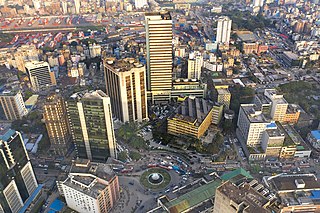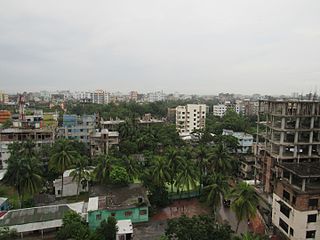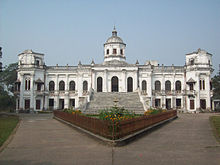
Dhaka, formerly known as Dacca, is the capital and largest city of Bangladesh. It is the ninth-largest and seventh-most densely populated city in the world. Dhaka is a megacity, and has a population of 10.2 million residents as of 2022, and a population of over 22.4 million residents in Greater Dhaka. It is widely considered to be the most densely populated built-up urban area in the world. Dhaka is the most important cultural, economic, and scientific hub of Eastern South Asia, as well as a major Muslim-majority city. Dhaka ranks third in South Asia and 39th in the world in terms of GDP. Lying on the Ganges Delta, it is bounded by the Buriganga, Turag, Dhaleshwari and Shitalakshya rivers. Dhaka is also the largest Bengali-speaking city in the world.

Dhaka Division is an administrative division within Bangladesh. Dhaka serves as the capital city of the Dhaka Division, the Dhaka District and Bangladesh. The division remains a population magnet, covers an area of 20,508.8 km2 with a population in excess of 44 million, growing at 1.94% rate since prior count, compared with national average of 1.22%. However, national figures may include data skewing expatriation of male labor force as gender ratio is skewed towards females.

Comilla District, officially known as Cumilla District, is a district of Bangladesh located about 100 kilometres south east of Dhaka. Comilla is bordered by Brahmanbaria and Narayanganj districts to the north, Noakhali and Feni districts to the south, Tripura of India to the east and Munshiganj and Chandpur districts to the west. Comilla district is located in the southeastern part of Bangladesh.

Kurigram District is a district of Bangladesh in the Rangpur Division. The district is located in northern Bangladesh along the country's border with India. Under Indian rule, the area was organized as a mahakuma and was not established as a district until 1984.

Mymensingh is a district in Mymensingh Division, Bangladesh, and is bordered on the north by Meghalaya, a state of India and the Garo Hills, on the south by Gazipur District, on the east by the districts of Netrokona and Kishoreganj, and on the west by the districts of Sherpur, Jamalpur and Tangail. Mymensingh is the 8th administrative divisional headquarter and 12th city corporation of Bangladesh. According to Ministry of Public Administration, Mymensingh is ranked 4th in district status. The density of Mymensingh city is 44,458/km2 which is the second most densely populated city in Bangladesh. Mymensingh attracts 25 percent of health tourists visiting Bangladesh. Once known as the largest district of the Indian subcontinent. Mymensingh town is the district headquarters. Mymensingh had the largest economy in the nation until Mohokuma Tangail rebelled and took over more than one-third of its land by the support of Pakistan's dictatorship.

Rangpur is one of the major cities in Bangladesh and Rangpur Division. Rangpur was declared a district headquarters on December 16, 1769, and established as a municipality in 1869, making it one of the oldest municipalities in Bangladesh. The municipal office building was erected in 1892 under the precedence Raja Janaki Ballav, Senior Chairman of the municipality. In 1890, the Shyamasundari canal was excavated for the improvement of the town. Sharfuddin Ahmed Jhantu was first mayor of Rangpur City Corporation. Now Rangpur City Corporation is the 2nd largest city corporation in Bangladesh. it's about 205 square kilometres. Rangpur is famous for Shataranji, Haribhanga (mango), Rangpur (fruit) and tobacco. Rangpur is called Baher Desh.

Gaibandha is a district in Northern Bangladesh. It is a part of the Rangpur Division. Gaibandha subdivision was established in 1875. Gaibandha was previously known as Bhabanigonj. The name was changed from Bhabanigonj to Gaibandha in 1875. Gaibandha was established as a district on 15 February 1984. Gaibandha is the administrative headquarters and largest urban centre of this district.

Lalmonirhat is a district, situated at the northern border of Bangladesh. It is a part of the Rangpur Division. Lalmonirhat mahakuma was established as a district on 1 February 1984. It lies north of Kochbihar and Jalpaiguri of West Bengal, south of Rangpur, east of Kurigram and Kochbihar and west of Rangpur and Nilphamari district. The international border line of Lalmonirhat district is 281.6 km long.

Nilphamari district is a district in Northern Bangladesh. It is a part of the Rangpur Division. It is about 400 kilometers to the northwest of the capital Dhaka. It has an area of 1,580.85 square kilometres (610.37 sq mi). Nilphamari is bounded by Rangpur and Lalmonirhat in east, Rangpur and Dinajpur in south, Dinajpur and Panchagarh in west, Cooch Behar of India in north. There are many rivers in Nilphamari including the Tista, Buritista, Isamoti, Jamuneshwari, Dhum, Kumlai, Charalkata, Sorbomongola, Salki, Chikli, Chara and Deonai. There are four Municipal Corporation in Nilphamari district. Area of these Municipalities are Nilphamari 42.70 SqKm(27.50 SqKm Present, 15.20 SqKm Ongoing), Saidpur-34.42 SqKm, Jaldhaka-28.22 SqKm and Domar-9.421 SqKm. There are 60(sixty) Unions, 370 Moujas and 378 Village in Nilphamari district.

Rangpur is a district in Northern Bangladesh. It is a part of the Rangpur Division.

Sandwip is an island located along the southeastern coast of Bangladesh in the Chattogram District. Along with the island of Urir Char,Jahajjar Char and those are the part of the Sandwip Upazila.

Bangladesh is divided into 8 divisions (bibhag) and 64 districts, although these have only a limited role in public policy. For the purposes of local government, the country is divided into upazilas (sub-districts), "municipalities" or town councils (pourashova), city corporations and union councils . The diagram below outlines the five tiers of government in Bangladesh.

Dhaka (Dacca) is one of the oldest inhabited mega cities of the World. The history of Dhaka begins with the existence of urbanised settlements in the area that is now Dhaka dating from the 7th century CE. The city area was ruled by the Hindu Gauda Kingdom, Buddhist and Shaivite Pala Empire before passing to the control of the Hindu Sena dynasty in the 10th century CE. After the Sena dynasty, the city was ruled by the Hindu Deva Dynasty. Dhaka was successively ruled by the Turkic and Afghan governors descending from the Delhi Sultanate, followed by the Bengal Sultanate, before the arrival of the Mughals in 1608. The city became proto-industrialised and declared capital of the Mughal Bengal and commercial (financial) capital of the Mughal India. The Dhaka natural riverine port has a recorded existence since the 16th century CE. Dhaka's strategic riverine location in Bengal made it a hub for Eurasian traders, including Armenians, the Portuguese, French, Dutch and British. The bustling old city was known as the Venice of the East. After Mughals, British ruled the region for 200 years until the independence of India in 1947. After the independence of Bangladesh in 1971, Dhaka became the capital of the new state.
Phulbari is an upazila of Kurigram District in the Division of Rangpur, Bangladesh.
Kurigram Sadar is an upazila of Kurigram District in the Division of Rangpur, Bangladesh.
Ulipur is an upazila of Kurigram District in the Rangpur Division, Bangladesh.
Mithapukur is an upazila of Rangpur District in the division of Rangpur, Bangladesh. The upazila is situated in the middle of Rangpur, surrounded by Rangpur Sadar to the north, Pirganj to the south, Badarganj and Phulbari to the west and Pirgachha and Sundarganj to the east. Mithapukur is famous for being the birthplace of Begum Rokeya Sakhawat Hossain and its sweet mango Harivanga.

Ramna Thana is a police jurisdiction in central Dhaka. It is a historic colonial neighborhood. Once the site of Mughal gardens, it developed into an institutional area during British rule in the late 19th century. It became a focal point for Dhaka's modernization in the 1960s. It was the scene of many tumultuous events that ushered the independence of Bangladesh in 1971. The Ramna Thana falls under the jurisdiction of the Dhaka South City Corporation.

Rangpur Division is one of the Divisions in Bangladesh. It was formed on 25 January 2010, as Bangladesh's 7th division. Before that, it was under Rajshahi Division. The Rangpur division consists of eight districts. There are 58 Upazilas or subdistricts under these eight districts. Rangpur is the northernmost division of Bangladesh and has a population of 17,610,956 in the 2022 Census.

Kurigram-3 is a constituency represented in the Jatiya Sangsad of Bangladesh since 2019 by MA Matin of the Awami League.

















